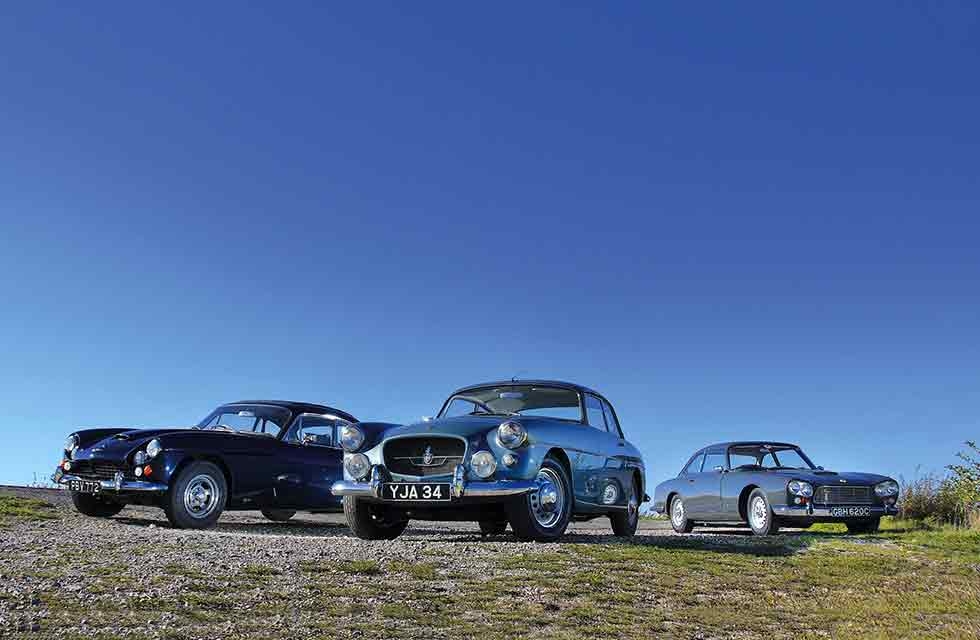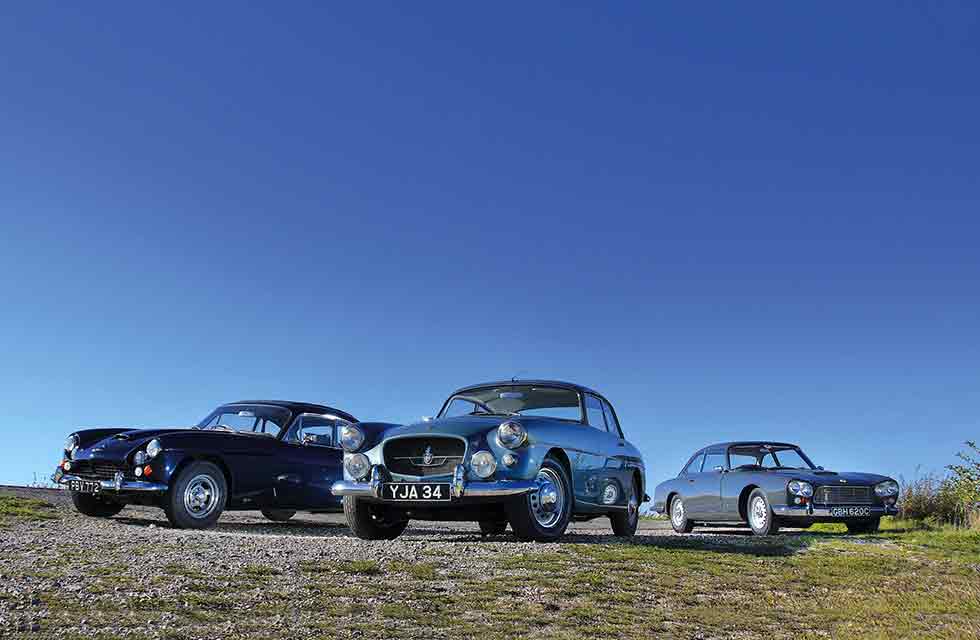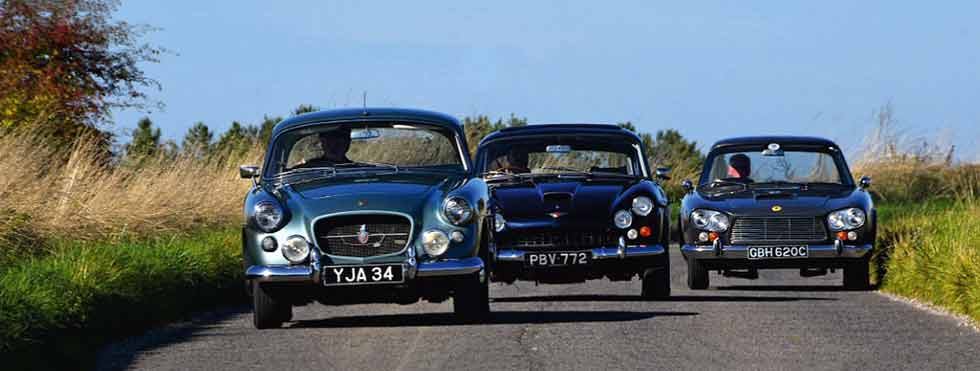
British beef with American muscle. When Bristol, Jensen and Gordon-Keeble needed more power in the ’60s, Yankee V8s came to the rescue. Words Martin Buckley. Photography John Bradshaw.
V8 GREATS – BRISTOL, JENSEN AND KEEBLE TRANSATLANTIC HYBRIDS Martin Buckley tries to pick a winner from three of his favourite V8s: Jensen C-V8, Bristol 407 and Gordon-Keeble
Grand Touring was well on the way to becoming one of the most debased and meaningless terms in the lexicon of motoring language even in the early ’60s, but there is no denying that the Jensen C-V8, Bristol 407 and Gordon-Keeble GK1 toured very grandly indeed by the standards of almost 60 years ago.

Subverting the notion that really fast cars had to be delicate, difficult to own and demanding to drive, these were the first of the Anglo-American GTs: luxurious 130mph fourseaters that put racing-car-like acceleration within the experience of anyone with three or four thousand pounds to spend.
‘At £2798 on launch, many speculated that the Gordon-Keeble was too timidly priced to make money’
That was still a great deal of money in circa 1961-’1962 so, although these American-engined English GT cars were typically £800-1000 cheaper than their ‘pure-bred’ competition, they were never exactly the poor man’s alternative. Rather, they were aimed at mature and responsible individuals who wanted a vehicle that would work for its living, was not highly strung, but could soothe or excite on command. Not by means of redline revs and racing changes, but by the simple expedient of silkily abundant torque (peaking at no more than 3000rpm) in a car that weighed half as much as the American family sedan the engine was designed for.

The 407, C-V8 and GK1 still look and feel quick cars now as we motor across Salisbury Plain on a bright day. Of the three, the Bristol, on its tall, skinny 16in wheels, is aloof and quiet, somewhat separate from the more visceral Jensen and Keeble. This pair, with their angry headlights, GRP bodywork and startling acceleration, were once among the fastest means yet devised of transporting four full-sized people on a public highway. They are cars I have often dreamed about (and driven), but never quite owned. If I don’t feel the need any more, that doesn’t mean I cannot see the appeal: there is something seductive about a breed of’60s car that could play the boardroom limousine during the week and do the Brighton Speed Trials at the weekend – or, in the case of the C-V8, even set the caravan towing record – yet required no more skill than any other car on the road.
‘The Jensen corners flat and quite neutrally on its firm and mainly BMC-derived suspension’
There was, of course, nothing new or particularly clever about putting lots of American cubic inches into your English chassis, particularly when, by the beginning of the ’60s, the hefty flat- heads that had powered the old Railtons and Brough Superiors had long since given way to a generation of oversquare, relatively light V8s with refinement, durability and cost-effective power that could not be found elsewhere.
Produced by the million, these high-compression engines, neither as heavy nor as large as might be expected, could be bought for a few hundred pounds from General Motors, Chrysler or Ford, and usually came with the latest smooth automatic gearboxes. If they were not things of highly polished beauty, who cared? Installed in a light chassis with proper brakes, suspension and steering, the results were obvious.
So it is hardly surprising that Jensen, Bristol and a newcomer from Southampton (via Slough) called Gordon-Keeble should come to the same conclusion. In fact, for the men at Filton and West Bromwich it was really Hobson’s choice: their ageing straight-sixes had reached the limit of their development potential in cars that were getting heavier and more luxurious every year.
At Jensen, which specialised in making bodies for other people and did its own-brand GT cars as a sideline, there was never any question of doing an in-house engine.
For Bristol Cars Ltd, by then a separate commercial entity from its aerospace parent company, the funds to develop a new, bigger straight-six were simply not available any more. The customers were there, but not in the numbers that had bought the 2-litre cars in the sellers’ market of the early-to-mid ’50s.
Jensen had built up a similarly loyal following for its 4-litre Austin-engined, GRP-bodied 541-series cars, but the concept was running out of steam in the face of cheaper, faster and arguably better-looking Jaguar opposition.
If Jensen and Bristol embraced the American V8 to keep their existing cars competitive, the Gordon-Keeble (launched prematurely as the alloy-bodied Gordon GT prototype at Geneva in I960) was a car created from the beginning around, and because of, the availability and tremendous potential of this type of engine.
Officially launched in 1964 (at the Savoy hotel), the Gordon-Keeble project was beset with funding, parts supply and even human resources problems within its ever-changing management team for the rest of its official existence.
Yet there was nothing much wrong with the product: Jim Keeble’s spaceframe chassis, with de Dion rear suspension, was excellent, and the Bertone body looked as timelessly fresh and elegant when the final cars were built in 1966 as it had six years earlier.
If, for some, the adoption of glassfibre for the body on the production cars felt like a bit of a throwback to its Peerless and Warwick origins, then one look at the fit and finish of the panels engineered by Williams & Pritchard would almost certainly have left them convinced.
Built at Southampton Airport, and later in Sholing, all 99 Gordon-Keebles (or was it 100?) were four-speed manuals – but this car is the odd one out with a later auto conversion. All Keebles had a Corvette engine (like the Chevrolet-powered Peerless that inspired the car’s progenitor, John Gordon), but Chrysler power is the common link between the Bristol of 1961 and Jensen of 1962, although the C-V8 upstaged the 407 by sporting a bigger, 5.9-litre unit in the first 67 examples built in 1962 and ’1963.
For the Mkll and Mklll C-V8s, 6.3-litre engines were used, whereas Bristol stuck with 5.2 litres through to the 411, possibly because it was tied in to sourcing engines from Canada as a way of avoiding tax on goods imported from outside the Commonwealth.
The Torquefiite automatic transmission that came with both of these engines was deemed so good than any thoughts of a manual alternative in either car were soon forgotten.
Based on a box-section chassis with sophisticated torsion bars and a Watt linkage to suspend and restrain its solid rear axle, the Bristol’s long, narrow, three-box body was really a saloon that happened to have two doors, rather than a coupe. Its long-nose proportions – with the engine behind the front axle line – betrayed the pre-war BMW origins of the underpinnings.
Visually, the 16-gauge aluminium-panelled body, coachbuilt by Park Royal in London, was an adaptation of the 2.2-litre 406; outwardly, the quickest way to tell a 407 from a 406 was the lack of a repeater flasher on its roof. Underneath, the biggest change (other than the engine) was the adoption of new coil-sprung, unequal-length wishbone front suspension and a Maries steering box. The transverse leaf spring and steering rack had to go in order to make way for the big new V8, which was more than double the size and power of the old straight-six.
The C-V8 relationship with its 541 forebear was more general, in that it had a glassfibre body (ideal for short production runs and once again designed by Eric Neale) on a platform chassis of welded tubes and fabricated sections, plus a roughly similar wheelbase and track. But the 4in tubes were central rather than peripheral and the new shape, with its fiercely angled quad headlamps, had a more aggressive look, presumably to reflect the character of a car that would get to 120mph in half a minute and cruise at that speed without recourse to the secondary chokes of its four-barrel Carter carburettor.
Barrie Warrener’s C-V8 is a Mklll with the lowered scuttle. This does quite a lot to slim a shape that is imposing rather than beautiful but has a lot of good angles, mostly from the back.
Wolfrace wheels were a popular ’70s C-V8 mod, but I think these cars look best on their original BMC-sourced steels. Purists may shudder at the later, 7.2-litre Interceptor engine and centre gearchange/console modification, but the C-V8’s close relationship with the later Jensen has always lent itself to such things.
Warrener has modified the car to suit his own tastes and requirements. The list includes sensible items such as bigger, better engine fans, overheating being the Achille’s heel of almost any American engine in the more confined surroundings of a European engine bay. Having said that, access is almost Triumph Herald-like in the Jensen, because when the bonnet swings up, it takes the front wings with it.
Inside, the C-V8’s distinctive individual rear seats look like a pair of armchairs and the general surroundings are leather-swaddled English club land with lots of cubbyholes and lockers, and an air of quality well up with its exotic rivals. Its padded dash and seatbelts are a reminder that Jensen was a safety pioneer in fitting such things as standard, as well as being among the first to use four-wheel Dunlop discs on the 541.
In the plastic, the C-V8 somehow looks like the dashing hero’s car. It might not be beautiful but it looks purposefully muscular, while giving you flashbacks to the rousing opening credits of The Baron. There are those who considered the Interceptor to be a bit of hairdresser’s job in comparison, and I can sort of see why.
It is certainly a manly vehicle, with the sort of hill-levelling, horizon-drawing thrust that can still turn the majority of modern cars into distant specks in its squat rear window.
A handful of manual C-V8’s were built but, having driven one, it’s not difficult to see why they made only nine: as an automatic, its gears change so unobtrusively they are only betrayed by the level of hiss from the carburettor and the flick of the rev counter; 3500rpm gets you along very well for most purposes.
The Jensen corners flat and quite neutrally on its firm and mainly BMC-derived suspension, but even in the dry (with that ‘Powr Lok’ diff) its tail can be tweaked to advantage, or even disadvantage as the car’s owner apparently discovered on the way to our photoshoot. Stable and well balanced, the C-V8 is reassuringly firm in a manner that pleases people who say things such as, “I like a car with a hard ride.” Its hefty, precise manual steering kicks back over bumps and potholes for a no-nonsense vintage flavour, which does somehow give the C-V8 a character distinct from that of the Interceptor.
The Bristol has a more suave personality. It is usefully fast but not startlingly so, as if to disturb its occupants with too much acceleration would not have been quite the thing. It wafts you along quietly in a beautifully crafted but quite plain interior, the handsome instrument nacelle framed by a big, black wheel with classic Bristol dropped spokes, hinting strongly at the car’s aircraft connections. Naturally, the gearchange is superb – the pushbuttons to the right of the steering are fun – and the ride is generally excellent in a way that filters out the worst offenders but still feels firmly controlled.
The 407 glides through country-lane curves and main-road roundabouts in a thoroughly stable and stately manner – one that its lofty seating position and the noble views down its shapely bonnet seem to dictate. It handles very well, in fact, only suffering in comparison with later V8 Bristols, which understeered less and, from the 409 onwards, had really good power steering to mask the sensation of ploughing on.
It is also worth mentioning that the 407 was quite a lot more expensive when new than either the Jensen or the Keeble, topping £5000. That figure included more than £1600 of Purchase Tax, which made these cars a hard sell at the time. Even secondhand, the 407s were never the most favoured of the V8s. In fact, they were so cheap even I owned one once!
But that was 15 years ago. Today the 407, perhaps the best looking of the V8 models, has been dragged up on the coat-tails of general classic car prices and the increased awareness of Bristol. Even so, there can few that have enjoyed the attention lavished upon this concours example (owned by Ian Warrener, brother of Barrie), which is the best 407 I have ever seen.
The Gordon-Keeble was the car I was most looking forward to driving. I fell in love with the first one I ever drove 30 years ago, and while subsequent exposure to them has left me not quite so overwhelmed by their steering (why is there almost zero castor return?) and other details, I still think they’re fabulous things: beautiful to look at in the manner of a Lancia Flaminia GT, but with real urge from a V8 that, on balance, feels the sweetest here.
This 1965 GK1 is the 77th built, converted to automatic in 1988 by the late Ernie Knott. I can see why someone might want to make a self- shifting Keeble, and the maker would doubtless have offered one had the car lived on. But to forgo the feeling of absolute control over such formidable power and torque that the original hefty, short-throw Corvette manual gave you seems a shame. Think about 72mph in second or, if you like, slot straight from first to top at 30 or 40mph and let the torque pull you to 130mph and beyond. By normal ’60s standards that must have felt like a jet eating up a runway rather than a motoring experience. Thus it is appropriate that, as in the Bristol, there are aircraft overtones to the GKl’s airy cabin, not just in the appearance of its padded, quilted, seven-dial fascia, but even in terms of actual components, such as the airliner-type eyeball heating vents in the sills.
Curiously, it is the only one of these cars with electric windows (quick, powerful ones) and it doesn’t seem to matter that its seats are PVC-trimmed rather than leather.
After all, for £2798 at launch you still got a radio, seatbelts and even a fire extinguisher as standard, leading many to speculate, perhaps uniquely in motoring history, that the Gordon-Keeble was too timidly priced to make money.
All but nine of the original cars are still around, an unusually healthy survival rate. In fact, all three of these fine machines are much rarer than the Astons, Bentleys and even Ferraris and Maseratis with which they compared them
selves in period (total production of all three comes to fewer than 700), and the respect they now command is reflected in their price-tags of up to £90k in this sort of condition.
Yet if you chopped in all three today for their full value, it still wouldn’t get you halfway into a DB5. So maybe, in the grand scheme of things, these are still cheap cars.
Thanks to the owners and Richard Hackett of SLJ Hackett, where the 407 and Gordon-Keeble are for sale (01985 219551; sljhackett.co.uk)
TECHNICAL DATA FILE SPECIFICATIONS 1964 Gordon-Keeble GK1
Sold/no built 1964-‘1966/99
Construction steel spaceframe chassis, glassfibre body
Engine all-iron, ohv 5354cc Chevrolet V8, with Carter four-barrel carburetor
Max power 300bhp @ 5000rpm / DIN nett
Max torque 360lb ft @ 3000rpm / DIN nett
Transmission four-speed manual (later auto fitted), RWD
Suspension: front wishbones, coil springs rear de Dion axle, trailing arms, coil springs, Watt linkage Steering Maries worm and roller
Brakes Girling discs
Length 15ft 9 ½in (4813mm)
Width 5ft 8in (1727mm)
Height 4ft 6in (1372mm)
Wheelbase 8ft 6in (2591mm)
Weight 3164lb (1435kg)
0-60mph 7.5 secs
Top speed 137mph
Mpg 14-19
Price new (1964 UK) £2798
Price now (2019 UK) £50,000-90,000
TECHNICAL DATA FILE SPECIFICATIONS 1965 Jensen C-V8 MkIII
Sold/no built 1962-’1966/499 (all types)
Construction steel-tube chassis, glassfibre body
Engine all-iron, ohv 6276cc Chrysler V8, Carter four-barrel carburetor
Max power 330bhp @ 4600rpm / DIN nett
Max torque 425lb ft @ 2800rpm / DIN nett
Transmission three-speed automatic, RWD
Suspension: front wishbones, coil springs, anti-roll bar rear live Salisbury axle, semi-elliptic leaf springs Steering rack and pinion
Brakes Dunlop discs
Length 15ft 4 ½ in (4686mm)
Width 5ft 7in (1702mm)
Height 4ft 7in (1397mm)
Wheelbase 8ft 9in (2667mm)
Weight 3332lb (1511kg)
0-60mph 6.7 secs
Top speed 130mph
Mpg 12-16
Price new (1962 UK) £3491
Price now (2019 UK) £40,000-80,000
TECHNICAL DATA FILE SPECIFICATIONS Bristol 407
Sold/no built 1961-‘1963/88
Construction steel chassis, aluminium body
Engine all-iron, ohv 5130cc Chrysler V8, with Carter four-barrel carburetor
Max power 250bhp @ 4400rpm / DIN nett
Max torque 340lb ft @ 2800rpm / DIN nett
Transmission three-speed automatic, RWD
Suspension: front wishbones, coil springs, anti-roll bar rear live axle, torsion bars, Watt linkage
Steering Maries worm and roller
Brakes Dunlop discs, with servo
Length 16ft 7in (5055mm)
Width 5ft 8in (1727mm)
Height 5ft (1524mm)
Wheelbase 9ft 6in (2896mm)
Weight 3640lb (1651kg)
0-60mph 9.2 secs
Top speed 125mph
Mpg 13-17
Price new (1961 UK) £5141
Price now (2019 UK) £40,000-80,000
Ian Warrener’s Bristol has had mild fettling over the years, including electric power steering for easier parking, and is deceptively quick cross-country. From top: subtly stylish interior and packed engine bay of Jensen; traditional Bristol wears signature two-spoke wheel and is beautifully finished; quilted dash and toggle switches give Chevy-engined GK1 a racy feel. It’s a purposefully styled thing, the C-V8, and its automatic gearbox swaps cogs beautifully, but don’t think that the tail can’t be provoked, even in the dry.







